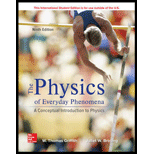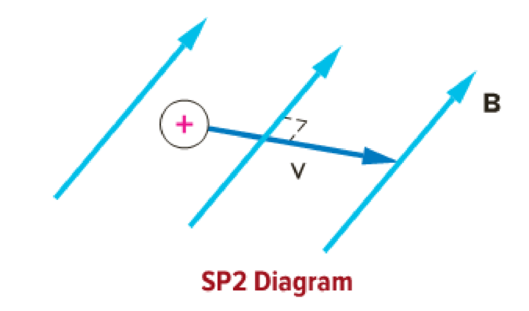
Concept explainers
A small metal ball with a charge of +0.08 C and a mass of 25 g (0.025 kg) enters a region where there is a magnetic field of 0.5 T. The ball is traveling with a velocity of 110 m/s in a direction perpendicular to the magnetic field, as shown in this problem's diagram.
a. What is the magnitude of the magnetic force acting on the ball?
b. What is the direction of the magnetic force exerted on the ball when it is at the position shown?
c. Will this force change the magnitude of the velocity of the ball? Explain.
d. From Newton’s second law, what is the magnitude of the acceleration of the charged hall?
e. Because centripetal acceleration is equal to v2/r, what is the radius of the curve the ball will move through under the influence of the magnetic force?

(a)
The magnitude of magnetic force on the ball.
Answer to Problem 2SP
Magnetic force on the ball is
Explanation of Solution
Given Info The charge of metal ball is
Write the equation for Lorentz magnetic force acting on ball moves in direction perpendicular to magnetic field.
Here,
Substitute
Conclusion:
Therefore, the force is
(b)
The direction of magnetic force on the ball.
Answer to Problem 2SP
Magnetic force acts into the page.
Explanation of Solution
Direction of magnetic force on ball is given by the right hand thumb rule. If the index finger denotes the direction of motion of ball, middle finger represents the direction of magnetic field; right hand thumb represents the direction of magnetic force. Force which is perpendicular to both velocity and magnetic field points into the page.
Conclusion:
Therefore, the Magnetic force acts into the page.
(c)
To Check: Whether the force on ball can change the velocity of ball or not.
Answer to Problem 2SP
Yes. Force on ball can change the velocity of ball.
Explanation of Solution
Magnetic force acting on the ball is perpendicular to both the direction of motion and magnetic field. This force put the ball in circular motion. The necessary centripetal force is provided by the magnetic force calculated in part (a).
In a circular motion, direction of motion is changing at every instant. This means even the speed of ball is constant, there will be a change in velocity.
Conclusion:
Therefore, the force on ball can change the velocity of ball.
(d)
The acceleration of charged ball.
Answer to Problem 2SP
The acceleration of ball is
Explanation of Solution
Given Info The charge of metal ball is
Write the formula to calculate the acceleration of ball.
Here,
Substitute
Conclusion:
Therefore, the acceleration of ball is
(e)
The radius of circular path which ball moves under the influence of magnetic field.
Answer to Problem 2SP
The radius of circular path is
Explanation of Solution
Given Info The charge of metal ball is
Write the equation for centripetal acceleration.
Here,
Rewrite the above relation in terms of
Substitute
Conclusion:
Therefore, the radius of circular path is
Want to see more full solutions like this?
Chapter 14 Solutions
Physics of Everyday Phenomena
- Mick and Rick are twins born on Earth in the year 2175. Rick grows up to be an Earth-bound robotics technician while Mick becomes an intergalactic astronaut. Mick leaves the Earth on his first space mission in the year 2200 and travels, according to his clock, for 10 years at a speed of 0.75c. Unfortunately, at this point in his journey, the structure of his ship undergoes mechanical breakdown and the ship explodes. How old is Rick when his brother dies?arrow_forwardHi, I have canceled, why did you charge me again?arrow_forwardNo chatgpt pls will upvotearrow_forward
 Physics for Scientists and EngineersPhysicsISBN:9781337553278Author:Raymond A. Serway, John W. JewettPublisher:Cengage Learning
Physics for Scientists and EngineersPhysicsISBN:9781337553278Author:Raymond A. Serway, John W. JewettPublisher:Cengage Learning Physics for Scientists and Engineers with Modern ...PhysicsISBN:9781337553292Author:Raymond A. Serway, John W. JewettPublisher:Cengage Learning
Physics for Scientists and Engineers with Modern ...PhysicsISBN:9781337553292Author:Raymond A. Serway, John W. JewettPublisher:Cengage Learning College PhysicsPhysicsISBN:9781938168000Author:Paul Peter Urone, Roger HinrichsPublisher:OpenStax College
College PhysicsPhysicsISBN:9781938168000Author:Paul Peter Urone, Roger HinrichsPublisher:OpenStax College
 College PhysicsPhysicsISBN:9781305952300Author:Raymond A. Serway, Chris VuillePublisher:Cengage Learning
College PhysicsPhysicsISBN:9781305952300Author:Raymond A. Serway, Chris VuillePublisher:Cengage Learning College PhysicsPhysicsISBN:9781285737027Author:Raymond A. Serway, Chris VuillePublisher:Cengage Learning
College PhysicsPhysicsISBN:9781285737027Author:Raymond A. Serway, Chris VuillePublisher:Cengage Learning





